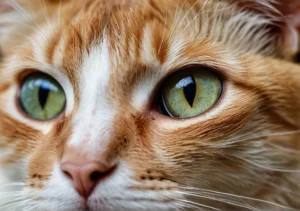Have you ever wondered why your cat can’t seem to catch that elusive red dot from a laser pointer? Despite their keen eyesight and hunting instincts, cats often struggle to capture the moving light. Let’s explore the reasons behind this puzzling phenomenon.
Mystery Solved: Why Cats Can’t See Laser Pointers
The Physiology of a Cat’s Vision
Have you ever noticed your cat struggling to track a fast-moving laser pointer? Well, there’s a fascinating reason behind this. You see, a cat’s vision is quite different from ours. While humans have high-resolution vision with a variety of colors, cats have a higher sensitivity to motion due to their evolutionary background as hunters.
Cats have more rod cells in their eyes than cone cells, which allows them to see better in low light but affects their ability to see fine details. This means that fast-moving objects, like a laser pointer, can be challenging for them to track accurately. So next time your feline friend seems to be confused by the elusive red dot, remember it’s just their unique vision at play.
Evolutionary Adaptations
Now, let’s delve into how your cat’s natural instincts and hunting strategies come into play when it comes to chasing that pesky laser pointer. Cats are predators by nature, honed by years of evolution to track and pounce on prey efficiently. When they see a quick-moving target, their instinct tells them to stalk and pounce, not just mindlessly chase it like a dog might.
So, when your cat seems more interested in the game of trying to catch the laser pointer than actually catching it, it’s because their instincts are telling them to stalk and hunt rather than just batting aimlessly at a dot. This behavior is a sign of their natural hunting instincts kicking in, even if the prey happens to be an elusive light.
Pro Tip: To satisfy your cat’s hunting instincts, try incorporating more interactive play with toys that mimic prey movements, such as feather wands or toys that simulate small animals’ behaviors. This not only provides mental stimulation but also satisfies their natural hunting urges.
Behavioral Responses to Laser Pointers
Have you noticed your cat losing interest in the laser pointer game? Cats, unlike humans, rely more on their sense of smell and hearing than sight. The elusive red dot from the laser pointer can be frustrating for our feline friends because they can’t catch or interact with it physically. It triggers their hunting instincts, but without any reward, it can lead to boredom or even anxiety.
To keep your cat engaged and satisfied, consider incorporating toys that allow them to use their natural skills, like interactive toys that dispense treats or wand toys they can chase and catch. These toys provide a tangible reward, making playtime more fulfilling for your cat. Remember, it’s essential to rotate toys regularly to keep things interesting and prevent boredom.
Potential Risks and Alternatives
While laser pointers can provide entertainment for both you and your cat, there are some potential risks to consider. Cats can become frustrated when they can’t catch the elusive dot, leading to increased stress and anxiety. Additionally, the sudden movements and frantic chase can be overstimulating for some cats, potentially resulting in behavior issues.
Instead of relying solely on the laser pointer, consider engaging your cat in more interactive play sessions using toys they can physically interact with. Wand toys, balls, and feather toys can mimic natural hunting behaviors and provide your cat with the satisfaction of catching their prey. Not only does this type of play offer mental and physical stimulation, but it also strengthens the bond between you and your cat.
- Use Puzzle Feeders: These toys challenge your cat’s problem-solving skills and provide mental stimulation during meal times.
- Rotate Toys Regularly: Keep playtime exciting by introducing new toys and rotating them regularly to prevent boredom.
- Provide Scratching Posts: Cats love to scratch and stretch, so ensure they have appropriate outlets like scratching posts to fulfill their natural behaviors.
By understanding your cat’s preferences and providing engaging play options, you can create a fun and enriching environment that keeps your feline friend happy and healthy.
Fun Facts about Cat Vision
Cats have a highly specialized vision that sets them apart from humans. One interesting tidbit is that cats have excellent night vision, thanks to a specialized layer of cells in their eyes called the tapetum lucidum. This layer reflects light back through the retina, giving cats a ‘second chance’ to see in low light conditions.
Another fascinating fact is that while cats can see some colors, their color vision is not as vivid as ours. Cats primarily see in shades of blue and green, which is why they might not be as captivated by a red laser pointer as you’d expect. Understanding these unique aspects of your cat’s vision can help you tailor playtime activities to better suit their preferences and abilities.
Tips for Engaging Playtime
When it comes to engaging playtime with your feline friend, it’s essential to tap into their natural instincts to keep them entertained and mentally stimulated. Instead of relying on a laser pointer, which may not be as exciting for your cat, try interactive toys that mimic prey behavior, such as feather wands or string toys. These toys can satisfy your cat’s hunting instincts while providing physical exercise.
Another great way to keep your cat engaged is by incorporating puzzle feeders or treat-dispensing toys into playtime. These toys encourage your cat to ‘hunt’ for their food, keeping them mentally sharp and physically active. Additionally, rotating your cat’s toys regularly can prevent boredom and keep playtime fresh and exciting.
Remember, every cat is unique, so observe your cat’s preferences and play style to determine the toys and activities they enjoy most. By providing a variety of stimulating play options, you can create a fun and enriching environment for your feline companion.
Additional Insight: Consider trying out different textures and materials for your cat’s toys, such as crinkly fabrics or soft plush materials. Cats have sensitive paw pads and may enjoy the tactile experience of playing with different textures, adding a new dimension to their playtime.
Understanding Your Cat’s Needs
Hey there, cat parent! Providing mental and physical enrichment for your feline friend is crucial for their overall well-being and happiness. Cats are intelligent and curious creatures that need stimulation to keep them active and engaged. By incorporating interactive toys, puzzle feeders, scratching posts, and engaging play sessions into their daily routine, you can ensure that your cat is getting the mental and physical exercise they need to thrive. Remember, a happy cat is a healthy cat!
Why Can’t My Cat See a Laser Pointer?
When it comes to why your cat can’t see a laser pointer, it’s essential to understand that cats have a different type of vision than humans. Cats have more rod cells in their eyes, which are better for detecting motion in low light but not as sensitive to color or detail. This means that the red dot from a laser pointer may not register as clearly to your cat as it does to you. So, while your cat may enjoy chasing the elusive dot around, they may not actually “see” it in the same way you do. Remember, it’s all about the thrill of the chase for your feline friend!
Tips for Keeping Your Cat Happy and Healthy:
- Provide various types of toys to keep your cat mentally stimulated
- Set up perches or climbing areas for your cat to explore vertically
- Offer a variety of scratching surfaces to promote healthy scratching behavior
- Rotate toys regularly to prevent boredom
- Incorporate playtime into your daily routine for bonding and exercise
Remember, a cat’s happiness is directly tied to their mental and physical well-being. By understanding and meeting your cat’s needs for mental and physical enrichment, you can ensure that they lead a fulfilling and happy life.
Alex, a passionate animal lover, has experience in training and understanding animal behavior. As a proud pet parent to two dogs and three cats, he founded AnimalReport.net to share insights from animal experts and expand his knowledge of the animal kingdom.




